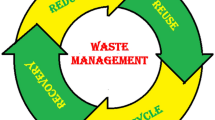Abstract
The removal of benzene, toluene, ethylbenzene, and xylene (BTEX) from aqueous solution by multi- and single-walled carbon nanotubes (MWCNTs and SWCNTs), hybrid carbon nanotubes (HCNTs) and nano-Fe was evaluated for a nanomaterials dose of 1 g/L and a BTEX concentration of 10 mg/L and pH 7. The equilibrium amount (q e ) (mg/g) removed by SWCNTs (B: 9.98, T: 9.96, E: 9.97, and X: 9.97 mg/g) was higher than for MWCNTs, HCNTs and nano-Fe in a c 0 of 10 mg/L and for a contact time of 10 min. The q e of total BTEX removed via SWCNTs was 39.89 mg/g. The order of uptake for SWCNTs is X > T = E > B, which is related to the increasing water solubility and the decreasing molecular weight of the compounds. The SWCNTs performed better for BTEX sorption than the MWCNTs, HCNTs and nano-Fe. The results of desorption study show that BTEX adsorbed on SWCNTs can easily be desorbed at 105 ± 2°C. It was concluded that recycling CNTs using heat improved the performance of the CNTs. For the first time, better adsorption performance was observed for recycled CNTs than for raw CNTs. SWCNTs are efficient BTEX adsorbents that could be used for cleaning up environmental pollution.
Similar content being viewed by others
References
Aivalioti, M., Vamvasakis, I., and Gidarakos, E., BTEX and MTBE adsorption onto raw and thermally modified diatomite, J. Hazard. Mater., 2010, vol. 178, nos. 1–3, pp. 136–143.
Bielefeldt, A.R. and Stensel, H.D., Evaluation of biodegradation kinetic testing methods and longterm variability in biokinetics for BTEX metabolism, Water Res., 1999, vol. 33, no. 3, pp. 733–740.
Carmody, O., Frost, R., Xi, Y., et al., Adsorption of hydrocarbons on organo-clays-implications for oil spill remediation, J. Colloid Interface Sci., 2007, vol. 305, no. 1, pp. 17–24.
Daifullah, A.A.M. and Girgis, B.S., Impact of surface characteristics of activated carbon on adsorption of BTEX, Colloids Surf. A, 2003, vol. 214, nos. 1–3, pp. 181–193.
Gomes, H.T., Samant, P.V., Serp, P., et al., Carbon nanotubes and xerogels as supports of well-dispersed Pt catalysts for environmental applications, Appl. Catal. B, 2004, vol. 54, no. 3, pp. 175–182.
Koh, S.-M. and Dixon, J.B., Preparation and application of organo-minerals as sorbents of phenol, benzene and toluene, Appl. Clay Sci., 2001, vol. 18, nos. 3–4, pp. 111–122.
Lin, S.H. and Huang, C.Y., Adsorption of BTEX from aqueous solution by macroreticular resins, J. Hazard. Mater., 1999, vol. 70, nos. 1–2, pp. 21–37.
Lu, C. and Su, F., Adsorption of natural organic matter by carbon nanotubes, Sep. Purif. Technol., 2007, vol. 58, no. 1, pp. 113–121.
Lu, C., Su, F., and Hu, S., Surface modification of carbon nanotubes for enhancing BTEX adsorption from aqueous solutions, Appl. Surf. Sci., 2008, vol. 254, no. 21, pp. 7035–7041.
Mathur, A.K., Majumder, C.B., and Chatterjee, S., Combined removal of BTEX in air stream by using mixture of sugar cane bagasse, compost and GAC as biofilter media, J. Hazard. Mater., 2007, vol. 148, nos. 1–2, pp. 64–74.
Mello, J.M.Md., de Lima Brandão, H., de Souza, A.A.U., et al., Biodegradation of BTEX compounds in a biofilm reactor—modeling and simulation, J. Pet. Sci. Eng., 2010, vol. 70, nos. 1–2, pp. 131–139.
Shim, H., Shin, E., and Yang, S.-T., A continuous fibrous-bed bioreactor for BTEX biodegradation by a co-culture of Pseudomonas putida and Pseudomonas fluorescens, Adv. Environ. Res., 2002, vol. 7, no. 1, pp. 203–216.
Su, F., Lu, C., and Hu, S., Adsorption of benzene, toluene, ethylbenzene and p-xylene by NaOCl-oxidized carbon nanotubes, Colloids Surf., A, 2010, vol. 353, no. 1, pp. 83–91.
Wibowo, N., Setyadhi, L., Wibowo, D., et al., Adsorption of benzene and toluene from aqueous solutions onto activated carbon and its acid and heat treated forms: influence of surface chemistry on adsorption, J. Hazard. Mater., 2007, vol. 146, nos. 1–2, pp. 237–242.
Yan, X.M., Shi, B.Y., Lu, J.J., et al., Adsorption and desorption of atrazine on carbon nanotubes, J. Colloid Interface Sci., 2008, vol. 321, no. 1, pp. 30–38.
Zytner, R.G., Sorption of benzene, toluene, ethylbenzene and xylenes to various media, J. Hazard. Mater., 1994, vol. 38, no. 1, pp. 113–126.
Author information
Authors and Affiliations
Corresponding author
Additional information
The article is published in the original.
Rights and permissions
About this article
Cite this article
Bina, B., Amin, M.M., Rashidi, A. et al. Water and wastewater treatment from BTEX by carbon nanotubes and Nano-Fe. Water Resour 41, 719–727 (2014). https://doi.org/10.1134/S0097807814060037
Received:
Published:
Issue Date:
DOI: https://doi.org/10.1134/S0097807814060037




